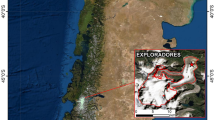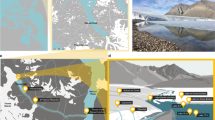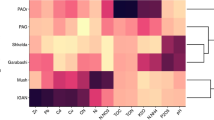Abstract
The diversity of highly active bacterial communities in cryoconite holes on three Arctic glaciers in Svalbard was investigated using terminal restriction fragment length polymorphism (T-RFLP) of the 16S rRNA locus. Construction and sequencing of clone libraries allowed several members of these communities to be identified, with Proteobacteria being the dominant one, followed by Cyanobacteria and Bacteroidetes. T-RFLP data revealed significantly different communities in holes on the (cold) valley glacier Austre Brøggerbreen relative to two adjacent (polythermal) valley glaciers, Midtre Lovénbreen and Vestre Brøggerbreen. These population compositions correlate with differences in organic matter content, temperature and the metabolic activity of microbial communities concerned. No within-glacier spatial patterns were observed in the communities identified over the 2-year period and with the 1 km-spaced sampling. We infer that surface hydrology is an important factor in the development of cryoconite bacterial communities.
Similar content being viewed by others
Login or create a free account to read this content
Gain free access to this article, as well as selected content from this journal and more on nature.com
or
Accession codes
References
Anderson MJ . (2001). A new method for non-parametric multivariate analysis of variance. Austral Ecol 26: 32–46.
Anderson MJ . (2005). PERMANOVA: A FORTRAN Computer Program for Permutational Multivariate Analysis of Variance. Department of Statistics, University of Auckland: New Zealand.
Anderson MJ, Willis TJ . (2003). Canonical analysis of principal coordinates: a useful method of constrained ordination for ecology. Ecology 84: 511–525.
Anesio AM, Hodson AJ, Fritz A, Psenner R, Sattler B . (2009). High microbial activity on glaciers: importance to the global carbon cycle. Global Change Biol 15: 955–960.
Anesio AM, Mindl B, Laybourn-Parry J, Hodson AJ, Sattler B . (2007). Viral dynamics in cryoconite holes on a high Arctic glacier (Svalbard). J Geophys Res (G Biogeosci) 112: G04S31, 10pp.
Ashelford KE, Chuzhanova NA, Fry JC, Jones AJ, Weightman AJ . (2005). At least 1 in 20 16S rRNA sequence records currently held in public repositories is estimated to contain substantial anomalies. Appl Environ Microbiol 71: 7724–7736.
Christner BC, Kvitko BH, Reeve JN . (2003a). Molecular identification of Bacteria and Eukarya inhabiting an Antarctic cryoconite hole. Extremophiles 7: 177–183.
Christner BC, Mosley-Thompson E, Thompson LG, Reeve JN . (2003b). Bacterial recovery from ancient glacial ice. Environ Microbiol 5: 433–436.
De Schryver P, Crab R, Defoirdt T, Boon N, Verstraete W . (2008). The basics of bio-flocs technology: the added value for aquaculture. Aquaculture 277: 125–137.
Deltas G . (2003). The small-sample bias of the Gini coefficient: Results and implications for empirical research. Rev Econ Stat 85: 226–234.
Dorfman R . (1979). Formula for the Gini coefficient. Rev Econ Stat 61: 146–149.
Dowdeswell JA, Hagen JO, Bjornsson H, Glazovsky AF, Harrison WD, Holmlund P et al. (1997). The mass balance of circum-Arctic glaciers and recent climate change. Quatern Res 48: 1–14.
Fountain AG, Tranter M, Nylen TH, Lewis KJ, Mueller DR . (2004). Evolution of cryoconite holes and their contribution to meltwater runoff from glaciers in the McMurdo Dry Valleys, Antarctica. J Glaciol 50: 35–45.
Gattinger A, Gunther A, Schloter M, Munich JC . (2003). Characterisation of Archaea in soils by polar lipid analysis. Acta Biotechnol 23: 21–28.
Gerdel RW, Drouet F . (1960). The cryoconite of the Thule area, Greenland. Trans Am Microsc Soc 79: 256–272.
Gleeson DB, Herrmann AM, Livesley SJ, Murphy DV . (2008). Influence of water potential on nitrification and structure of nitrifying bacterial communities in semiarid soils. Appl Soil Ecol 40: 189–194.
Gunde-Cimerman N, Sonjak S, Zalar P, Frisvad JC, Diderichsen B, Plemenitas A . (2003). Extremophilic fungi in arctic ice: a relationship between adaptation to low temperature and water activity. Phys Chem Earth 28: 1273–1278.
Hagen JO, Kohler J, Melvold K, Winther JG . (2003). Glaciers in Svalbard: mass balance, runoff and freshwater flux. Polar Res 22: 145–159.
Halet D, Boon N, Verstraete W . (2006). Community dynamics of methanotrophic bacteria during composting of organic matter. J Biosci Bioeng 101: 297–302.
Hambrey MJ, Murray T, Glasser NF, Hubbard A, Hubbard B, Stuart G et al. (2005). Structure and changing dynamics of a polythermal valley glacier on a centennial timescale: Midre Lovenbreen, Svalbard. J Geophys Res (Earth Surface) 110: F1.
Hammer Ø, Harper DAT, Ryan PD . (2001). PAST: Paleontological Statistics Software Package for Education and Data Analysis. Palaeontol Electronica 4: 9.
Hodgkins R . (1997). Glacier hydrology in Svalbard, Norwegian high Arctic. Quaternary Sci Rev 16: 957–973.
Hodson A, Anesio AM, Ng F, Watson R, Quirk J, Irvine-Fynn T et al. (2007). A glacier respires: Quantifying the distribution and respiration CO2 flux of cryoconite across an entire Arctic supraglacial ecosystem. J Geophys Res (G Biogeosci) 112: G04S36, 9pp.
Hodson A, Anesio AM, Tranter M, Fountain A, Osborn M, Priscu J et al. (2008). Glacial ecosystems. Ecol Monogr 78: 41–67.
Huber T, Faulkner G, Hugenholtz P . (2004). Bellerophon: a program to detect chimeric sequences in multiple sequence alignments. Bioinformatics 20: 2317–2319.
Lemke P, Ren J, Alley RB, Allison I, Carrasco J, Flato G et al. (2007). Observations: Changes in Snow, Ice and Frozen Ground. In: Solomon S, Qin D, Manning M, Chen Z, Marquis M, Averyt KB et al (eds). Contribution of Working Group I to the Fourth Assessment Report of the Intergovernmental Panel on Climate Change. Cambridge University Press: Cambridge, UK and New York, NY, USA.
Liu WT, Marsh LT, Cheng H, Forney LJ . (1997). Characterization of microbial diversity by determining terminal restriction fragment length polymorphisms of genes encoding 16S rRNA. Appl Environ Microbiol 63: 4516–4522.
Margesin R, Zacke G, Schinner F . (2002). Characterization of heterotrophic microorganisms in alpine glacier cryoconite. Arct Antarct Alp Res 34: 88–93.
Marzorati M, Wittebolle L, Boon N, Daffonchio D, Verstraete W . (2008). How to get more out of molecular fingerprints: practical tools for microbial ecology. Environ Microbiol 10: 1571–1581.
McArdle BH, Anderson MJ . (2001). Fitting multivariate models to community data: a comment on distance-based redundancy analysis. Ecology 82: 290–297.
Mueller DR, Pollard WH . (2004). Gradient analysis of cryoconite ecosystems from two polar glaciers. Polar Biol 27: 66–74.
Mueller DR, Vincent WF, Pollard WH, Fritsen CH . (2001). Glacial cryoconite ecosystems: a bipolar comparison of algal communities and habitats. Nova Hedwigia 123: 173–197.
Nicol GW, Tscherko D, Chang L, Hammesfahr U, Prosser JI . (2006). Crenarchaeal community assembly and microdiversity in developing soils at two sites associated with deglaciation. Environ Microbiol 8: 1382–1393.
Nienow PW, Hubbard B . (2005). Surface and englacial drainage of glaciers and ice sheets. In: Anderson M (ed). Encyclopedia of Hydrological Sciences. John Wiley & Sons: London. pp 2575–2586.
Nikolcheva LG, Barlocher F . (2005). Seasonal and substrate preferences of fungi colonizing leaves in streams: traditional versus molecular evidence. Environ Microbiol 7: 270–280.
Pointing SB, Chan Y, Lacap DC, Lau MCY, Jurgens JA, Farrell RL . (2009). Highly specialized microbial diversity in hyper-arid polar desert. Proc Natl Acad Sci USA 106: 19964–19969.
Porazinska DL, Fountain AG, Nylen TH, Tranter M, Virginia RA, Wall DH . (2004). The biodiversity and biogeochemistry of cryoconite holes from McMurdo Dry Valley glaciers, Antarctica. Arct Antarct Alp Res 36: 84–91.
Säwström C, Mumford P, Marshall W, Hodson A, Laybourn-Parry J . (2002). The microbial communities and primary productivity of cryoconite holes in an Arctic glacier (Svalbard 79 degrees N). Polar Biol 25: 591–596.
Sjöling S, Cowan DA . (2003). High 16S rDNA bacterial diversity in glacial meltwater lake sediment, Bratina Island, Antarctica. Extremophiles 7: 275–282.
Stibal M, Sabacka M, Kastovska K . (2006). Microbial communities on glacier surfaces in Svalbard: impact of physical and chemical properties on abundance and structure of cyanobacteria and algae. Microb Ecol 52: 644–654.
Stibal M, Tranter M, Benning LG, Rehak J . (2008). Microbial primary production on an Arctic glacier is insignificant in comparison with allochthonous organic carbon input. Environ Microbiol 10: 2172–2178.
Sturmm W, Morgan JJ . (1970). Aquatic chemistry: An Introduction Emphasizing Chemical Equilibria in Natural Waters. Wiley Interscience: New York.
Takeuchi N . (2002). Optical characteristics of cryoconite (surface dust) on glaciers: the relationship between light absorbency and the property of organic matter contained in the cryoconite. Ann Glaciol 34: 409–414.
Takeuchi N, Kohshima S, Seko K . (2001). Structure, formation, and darkening process of albedo-reducing material (cryoconite) on a Himalayan glacier: a granular algal mat growing on the glacier. Arct Antarct Alp Res 33: 115–122.
Takeuchi N, Kohshima S, Yoshimura Y, Seko K, Fujita K . (2000). Characteristics of cryoconite holes on a Himalayan glacier, Yala glacier, Central Nepal. Bull Glaciol Res 17: 51–59.
ter Braak CJF . (1986). Canonical correspondence analysis: a new eigenvector technique for multivariate direct gradient analysis. Ecology 67: 1167–1179.
Tranter M, Fountain AG, Fritsen CH, Lyons WB, Priscu JC, Statham PJ et al. (2004). Extreme hydrochemical conditions in natural microcosms entombed within Antarctic ice. Hydrological Processes 18: 379–387.
Vainio EJ, Hallaksela AM, Lipponen K, Hantula J . (2005). Direct analysis of ribosomal DNA in denaturing gradients: application on the effects of Phlebiopsis gigantea treatment on fungal communities of conifer stumps. Mycol Res 109: 103–114.
Weiner J, Solbrig OT . (1984). The meaning and measurement of size hierarchies in plant populations. Oecologia 61: 334–336.
Wharton RA, Vinyard WC, Parker BC, Simmons GM, Seaburg KG . (1981). Algae in cryoconite holes on Canada Glacier in Southern Victorialand, Antarctica. Phycologia 20: 208–211.
Wittebolle L, Vervaeren H, Verstraete W, Boon N . (2008). Quantifying community dynamics of nitrifiers in functionally stable reactors. Appl Environ Microbiol 74: 286–293.
Acknowledgements
We wish to express our gratitude for the support provided by the Ny Ålesund community, especially Nick Cox, Rick Atkinson and Rob Smith at the NERC Arctic Research Station. This study was supported by Grants from NERC (NERC NE/D007321/1; NERC NE/G00496X/1) and the Royal Society (RS 2006/R2) to the authors, a PhD scholarship to AE from the Higher Education Funding Council for Wales (Mantais) and funding from the Austrian Academy of Sciences (OEAW) to BS. We thank Dr Tim James and the SLICES project (NERC NE/B505203/1), as well as Dr David Rippin and Dr Jack Kohler for providing GIS mapping data; Dr David Ratkowsky and Dr Gustaf Hendeby for discussions regarding multivariate data analysis; Tommy Ridgeway of IGES for preparing thin sections of cryoconite; and Hilary Worgan and Beatriz Macias of IBERS for assistance with T-RFLP.
Author information
Authors and Affiliations
Corresponding author
Additional information
Supplementary Information accompanies the paper on The ISME Journal website
Supplementary information
Rights and permissions
About this article
Cite this article
Edwards, A., Anesio, A., Rassner, S. et al. Possible interactions between bacterial diversity, microbial activity and supraglacial hydrology of cryoconite holes in Svalbard. ISME J 5, 150–160 (2011). https://doi.org/10.1038/ismej.2010.100
Received:
Revised:
Accepted:
Published:
Issue Date:
DOI: https://doi.org/10.1038/ismej.2010.100
Keywords
This article is cited by
-
High prevalence of parasitic chytrids infection of glacier algae in cryoconite holes in Alaska
Scientific Reports (2023)
-
Geographical variability of bacterial communities of cryoconite holes of Andean glaciers
Scientific Reports (2023)
-
Factors controlling the net ecosystem production of cryoconite on Western Himalayan glaciers
Biogeochemistry (2023)
-
Comparison of prokaryotes between Mount Everest and the Mariana Trench
Microbiome (2022)
-
MinION sequencing from sea ice cryoconites leads to de novo genome reconstruction from metagenomes
Scientific Reports (2021)



